This 1935 film by Frank R Strayer was recommended to me for a ‘Vamp or Not?’ feature by Exclamation Mark and also mentioned by Mateo, who had visited to see if I had already looked at the film. First of all I must apologise for the poor screenshots but the quality of the DVD transfer was poor indeed.
The film shares many elements of Strayer’s earlier film The Vampire Bat (1933), yet there are glaring differences in story and, more than that, glaring differences in quality. This is a poverty row film, the film did not attract the same level of stars and the acting is poor, one might even describe it as extremely wooden, the dialogue is awful and, in short, it is not a patch on the earlier film.
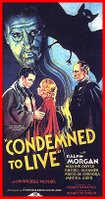 The film starts in Africa, drums beat through the night and a woman, Martha (Barbara Bedford), lies in a cave. She is pregnant and with her is her husband Franz (Ferdinand Schumann-Heink) and Doctor Duprez (Robert Frazer). The Doctor and Franz discuss the situation. Duprez explains that the natives will not attack as they believe the cave to be cursed, it is filled with vampire bats. Martha screams and a (rather poor looking) bat has attached itself to her neck, they pull it from her… cut forward in time.
The film starts in Africa, drums beat through the night and a woman, Martha (Barbara Bedford), lies in a cave. She is pregnant and with her is her husband Franz (Ferdinand Schumann-Heink) and Doctor Duprez (Robert Frazer). The Doctor and Franz discuss the situation. Duprez explains that the natives will not attack as they believe the cave to be cursed, it is filled with vampire bats. Martha screams and a (rather poor looking) bat has attached itself to her neck, they pull it from her… cut forward in time.
A village is being terrorized, the second victim of murder most foul has been found. The victims are all found at a cave, their throats ripped open and their blood drained. The villagers turn to (too good to be true) goodly Professor Kristan (Ralph Morgan) for help, in fact they turn to him for help with every problem under the sun. The theory, to which he concurs, is that a giant bat is killing these people, dragging them off to the cave.
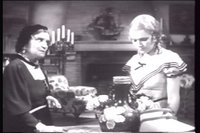 The only sceptic is David (Russell Gleason), who believes it to be the work of a human assailant. Kristan is engaged to a much younger girl, Marguerite (Maxine Doyle). She worships the professor, who hasn’t noticed that she loves him but is not in love with him. David also loves her, and believes she truly loves him. A love triangle, you might say, would add some intrigue to the film but little of substance is done with it. It is the mainstay of the film but it could have been used to a much greater effect – which would have added much needed tension to the film.
The only sceptic is David (Russell Gleason), who believes it to be the work of a human assailant. Kristan is engaged to a much younger girl, Marguerite (Maxine Doyle). She worships the professor, who hasn’t noticed that she loves him but is not in love with him. David also loves her, and believes she truly loves him. A love triangle, you might say, would add some intrigue to the film but little of substance is done with it. It is the mainstay of the film but it could have been used to a much greater effect – which would have added much needed tension to the film.
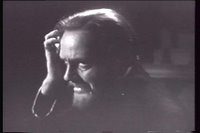 We quickly discover who the assailant is. Kristan is suffering headaches and passing out; when unconscious it is he who murders these folks. The only one who knows is his hunchback assistant Zan (Mishca Auer). Zan is dragging the victims to the cave in order to hide the Professor’s guilt and lying about the events, even to the oblivious Kristan.
We quickly discover who the assailant is. Kristan is suffering headaches and passing out; when unconscious it is he who murders these folks. The only one who knows is his hunchback assistant Zan (Mishca Auer). Zan is dragging the victims to the cave in order to hide the Professor’s guilt and lying about the events, even to the oblivious Kristan.
Things come to a head when Kristan’s foster father, Doctor Bizet (Pedro De Cordoba), visits and discovers the truth. Of course, by then the villagers have turned on Zan – but unlike the poor innocent in the earlier film he survives.
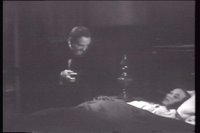 So far things are looking iffy on a vampire level. The bat motif seems a red herring and the killer is a man whose personality changes in an almost Jekyll and Hyde way. The source, however, seems to be psychological stress and causes Kristan to walk in a jerky manner, with a hand held up threateningly and a mad gleam to the eye. All we have to work with is village superstition and that is centred around a giant bat monster. The script then throws in a supernatural element.
So far things are looking iffy on a vampire level. The bat motif seems a red herring and the killer is a man whose personality changes in an almost Jekyll and Hyde way. The source, however, seems to be psychological stress and causes Kristan to walk in a jerky manner, with a hand held up threateningly and a mad gleam to the eye. All we have to work with is village superstition and that is centred around a giant bat monster. The script then throws in a supernatural element.
It seems that Bizet has been waiting for this day. The bat attack at the head of the film ultimately killed Martha, Kristan’s mother, and the doctor passed the infant to Duprez to foster and told him to beware the mark of the bat. If something isn’t done soon the attacks will become more frequent and he will turn utterly into the monster of his madness.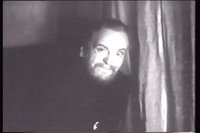 Okay, so we are told it is madness but the source seems to be an African curse, something Kristan could not know about. It is an unusual form of vampirism, more somnambulist and insanity based and certainly not undead. There is also a nice touch in that the attacks take place at night and there is a scene, which could have been brilliant but failed to hold tension, when Marguerite is switching off lights and as the room gets darker so Kristan’s headache intensifies until the room is black and his dark side takes control – this is a nice alternate use of the dark and light motif from the standard genre.
Okay, so we are told it is madness but the source seems to be an African curse, something Kristan could not know about. It is an unusual form of vampirism, more somnambulist and insanity based and certainly not undead. There is also a nice touch in that the attacks take place at night and there is a scene, which could have been brilliant but failed to hold tension, when Marguerite is switching off lights and as the room gets darker so Kristan’s headache intensifies until the room is black and his dark side takes control – this is a nice alternate use of the dark and light motif from the standard genre.
In a dark ending that belies the niceness of most of the characters in the film Kristan ends things by suicide – this is such a downbeat ending it becomes the highlight of the movie.
Because of the supernatural element, the curse of the bat, plus the use of light and dark as a dividing line for the two personalities, I am tempted to say that this deserves its place in the vampire filmographies. However I would recommend that you watch the earlier film as a much better movie with stronger performances and script.
The imdb page is here.
The film shares many elements of Strayer’s earlier film The Vampire Bat (1933), yet there are glaring differences in story and, more than that, glaring differences in quality. This is a poverty row film, the film did not attract the same level of stars and the acting is poor, one might even describe it as extremely wooden, the dialogue is awful and, in short, it is not a patch on the earlier film.
 The film starts in Africa, drums beat through the night and a woman, Martha (Barbara Bedford), lies in a cave. She is pregnant and with her is her husband Franz (Ferdinand Schumann-Heink) and Doctor Duprez (Robert Frazer). The Doctor and Franz discuss the situation. Duprez explains that the natives will not attack as they believe the cave to be cursed, it is filled with vampire bats. Martha screams and a (rather poor looking) bat has attached itself to her neck, they pull it from her… cut forward in time.
The film starts in Africa, drums beat through the night and a woman, Martha (Barbara Bedford), lies in a cave. She is pregnant and with her is her husband Franz (Ferdinand Schumann-Heink) and Doctor Duprez (Robert Frazer). The Doctor and Franz discuss the situation. Duprez explains that the natives will not attack as they believe the cave to be cursed, it is filled with vampire bats. Martha screams and a (rather poor looking) bat has attached itself to her neck, they pull it from her… cut forward in time.A village is being terrorized, the second victim of murder most foul has been found. The victims are all found at a cave, their throats ripped open and their blood drained. The villagers turn to (too good to be true) goodly Professor Kristan (Ralph Morgan) for help, in fact they turn to him for help with every problem under the sun. The theory, to which he concurs, is that a giant bat is killing these people, dragging them off to the cave.
 The only sceptic is David (Russell Gleason), who believes it to be the work of a human assailant. Kristan is engaged to a much younger girl, Marguerite (Maxine Doyle). She worships the professor, who hasn’t noticed that she loves him but is not in love with him. David also loves her, and believes she truly loves him. A love triangle, you might say, would add some intrigue to the film but little of substance is done with it. It is the mainstay of the film but it could have been used to a much greater effect – which would have added much needed tension to the film.
The only sceptic is David (Russell Gleason), who believes it to be the work of a human assailant. Kristan is engaged to a much younger girl, Marguerite (Maxine Doyle). She worships the professor, who hasn’t noticed that she loves him but is not in love with him. David also loves her, and believes she truly loves him. A love triangle, you might say, would add some intrigue to the film but little of substance is done with it. It is the mainstay of the film but it could have been used to a much greater effect – which would have added much needed tension to the film. We quickly discover who the assailant is. Kristan is suffering headaches and passing out; when unconscious it is he who murders these folks. The only one who knows is his hunchback assistant Zan (Mishca Auer). Zan is dragging the victims to the cave in order to hide the Professor’s guilt and lying about the events, even to the oblivious Kristan.
We quickly discover who the assailant is. Kristan is suffering headaches and passing out; when unconscious it is he who murders these folks. The only one who knows is his hunchback assistant Zan (Mishca Auer). Zan is dragging the victims to the cave in order to hide the Professor’s guilt and lying about the events, even to the oblivious Kristan.Things come to a head when Kristan’s foster father, Doctor Bizet (Pedro De Cordoba), visits and discovers the truth. Of course, by then the villagers have turned on Zan – but unlike the poor innocent in the earlier film he survives.
 So far things are looking iffy on a vampire level. The bat motif seems a red herring and the killer is a man whose personality changes in an almost Jekyll and Hyde way. The source, however, seems to be psychological stress and causes Kristan to walk in a jerky manner, with a hand held up threateningly and a mad gleam to the eye. All we have to work with is village superstition and that is centred around a giant bat monster. The script then throws in a supernatural element.
So far things are looking iffy on a vampire level. The bat motif seems a red herring and the killer is a man whose personality changes in an almost Jekyll and Hyde way. The source, however, seems to be psychological stress and causes Kristan to walk in a jerky manner, with a hand held up threateningly and a mad gleam to the eye. All we have to work with is village superstition and that is centred around a giant bat monster. The script then throws in a supernatural element.It seems that Bizet has been waiting for this day. The bat attack at the head of the film ultimately killed Martha, Kristan’s mother, and the doctor passed the infant to Duprez to foster and told him to beware the mark of the bat. If something isn’t done soon the attacks will become more frequent and he will turn utterly into the monster of his madness.
 Okay, so we are told it is madness but the source seems to be an African curse, something Kristan could not know about. It is an unusual form of vampirism, more somnambulist and insanity based and certainly not undead. There is also a nice touch in that the attacks take place at night and there is a scene, which could have been brilliant but failed to hold tension, when Marguerite is switching off lights and as the room gets darker so Kristan’s headache intensifies until the room is black and his dark side takes control – this is a nice alternate use of the dark and light motif from the standard genre.
Okay, so we are told it is madness but the source seems to be an African curse, something Kristan could not know about. It is an unusual form of vampirism, more somnambulist and insanity based and certainly not undead. There is also a nice touch in that the attacks take place at night and there is a scene, which could have been brilliant but failed to hold tension, when Marguerite is switching off lights and as the room gets darker so Kristan’s headache intensifies until the room is black and his dark side takes control – this is a nice alternate use of the dark and light motif from the standard genre.In a dark ending that belies the niceness of most of the characters in the film Kristan ends things by suicide – this is such a downbeat ending it becomes the highlight of the movie.
Because of the supernatural element, the curse of the bat, plus the use of light and dark as a dividing line for the two personalities, I am tempted to say that this deserves its place in the vampire filmographies. However I would recommend that you watch the earlier film as a much better movie with stronger performances and script.
The imdb page is here.

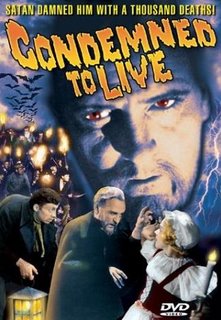















3 comments:
Wow, I didn't realize this movie was filmed after The Vampire Bat (it seems more primitive in a lot of ways).
Though obviously a poor film, I found the concept vaguely interesting. A great treatment here, though.
I hope you didn't spend too much obtaining this DVD. I'd feel guilty if you made any type of investment in this at all.
Mark the concept was intriguing but not expanded upon and lost within poor dialogue.
Never fear regarding the obtaining of this. I found it very cheap and when it came realised that it was one that I'd marked for getting at some point due to the Vampire Vat connection. Soeaking of which I agree, by look and quality, you'd have thought this was the earlier film.
dyslexic fingers again Vampire Bat noy Vat! lol
Post a Comment